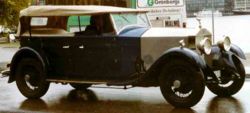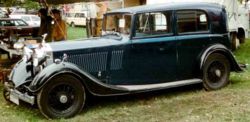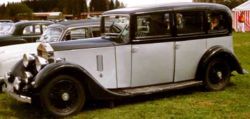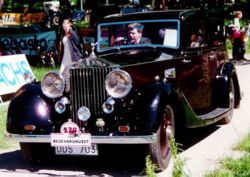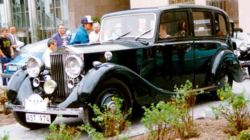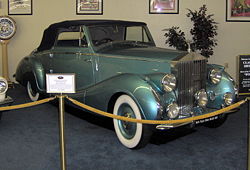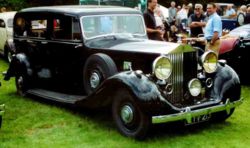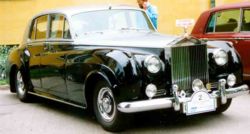Rolls-Royce Limited
2008/9 Schools Wikipedia Selection. Related subjects: Road transport
| Rolls-Royce Limited | |
|---|---|
| Fate | Nationalised / split |
| Successor | Rolls-Royce plc Rolls-Royce Motors demerged |
| Founded | 1906 by Charles Rolls and Henry Royce |
| Defunct | 1973 |
| Location | |
Rolls-Royce Limited was a British car and, later, aero-engine manufacturing company founded by Henry Royce and Charles Stewart Rolls on 15 March 1906 and was the result of a partnership formed in 1904. In 1971, Rolls-Royce was crippled by the development of the advanced RB211 jet engine, resulting in the nationalisation of the company. In 1973, the car division was separated from Rolls-Royce Limited as Rolls-Royce Motors. Rolls-Royce Limited continued as a nationalised company until it was privatised in 1987 as Rolls-Royce plc.
History
In 1884, Frederick Henry Royce started an electrical and mechanical business. He made his first car, a "Royce", in his Manchester factory in 1904. He was introduced to Charles Stewart Rolls at the Midland Hotel in Manchester on May 4 of that year, and the pair agreed to a deal where Royce would manufacture cars, to be sold exclusively by Rolls. A clause was added to the contract stipulating the cars would be called "Rolls-Royce". The company was formed on March 15, 1906, and moved to Derby in 1908.
The Silver Ghost (1906-1925) was responsible for the company's early reputation. It had a 6-cylinder engine; 6173 cars were built. In 1921, the company opened a second factory in Springfield, Massachusetts (in the United States to help meet demand), where a further 1701 "Springfield Ghosts" were built. This factory operated for 10 years, closing in 1931. Its chassis was used as a basis for the first British armoured car used in both world wars.
In 1931, the company acquired rival car maker Bentley, whose finances were unable to weather the Great Depression. From then until 2002, Bentley and Rolls-Royce cars were often identical apart from the radiator grille and minor details.
In 1933, the colour of the Rolls-Royce radiator monogram was changed from red to black because the red sometimes clashed with the coachwork colour selected by clients, and not as a mark of respect for the passing of Royce as is commonly stated.
Rolls-Royce and Bentley car production moved to Crewe in 1946, and also to Mulliner Park Ward, London, in 1959, as the company started to build bodies for its cars for the first time: previously it had built only the chassis, leaving the bodies to specialist coachbuilders.
Cars
- 1904-1906 10 hp
- 1905-1905 15 hp
- 1905-1908 20 hp
- 1905-1906 30 hp
- 1905-1906 V-8
- 1906-1925 40/50 Silver Ghost
- 1922-1929 Twenty
- 1925-1929 40/50 Phantom
- 1929-1936 20/25
- 1929-1935 Phantom II
- 1936-1938 25/30
- 1936-1939 Phantom III
- 1939-1939 Wraith
- 1946-1959 Silver Wraith
- 1949-1955 Silver Dawn
- 1950-1956 Phantom IV
- 1955-1965 Silver Cloud
- 1959-1968 Phantom V
- 1968-1992 Phantom VI
- 1965-1980 Silver Shadow
Bentley Models (from 1933)
- 1933-1937 Bentley 3½ L
- 1936-1939 Bentley 4¼ L
- 1939-1941 Bentley Mark V
Aero engines
The company's first aero engine was the Eagle, built from 1914. Around half the aircraft engines used by the Allies in World War I were made by Rolls-Royce. By the late 1920s, aero engines made up most of Rolls-Royce's business.
Henry Royce's last design was the Merlin aero engine, which came out in 1935, although he had died in 1933. This was developed after the R engine, which had powered a record-breaking Supermarine S6B seaplane to almost 400 mph in the 1931 Schneider Trophy. The Merlin was a powerful V12 engine and was fitted into many World War II aircraft: the British Hawker Hurricane, Supermarine Spitfire, De Havilland Mosquito (two-engine), Avro Lancaster (four-engine), Vickers Wellington (two-engine); it also transformed the American P-51 Mustang into possibly the best fighter of its time, its Merlin engine built by Packard under licence. Over 160,000 Merlin engines were produced. The Merlin crossed over into military vehicle use as the Meteor powering the Centurion tank among others.
In the post-World War II period Rolls-Royce made significant advances in gas turbine engine design and manufacture. The Dart and Tyne turboprop engines were particularly important, enabling airlines to cut times for shorter journeys whilst jet airliners were introduced on longer services. The Dart engine was used in Argosy, Avro 748, Friendship, Herald and Viscount aircraft, whilst the more powerful Tyne powered the Atlantique, C-160 and Vanguard, and the SR-N4 hovercraft. Many of these turboprops are still in service.
Amongst the jet engines of this period was the RB163 Spey, which powers the Hawker Siddeley Trident, BAC One-Eleven, Grumman Gulfstream II and Fokker F28.
During the late 1950s and 1960s there was a significant rationalisation of all aspects of British aerospace and this included aero-engine manufacturers, culminating in the merger of Rolls-Royce and Bristol Siddeley in 1966 (Bristol Siddeley had itself resulted from the merger of Armstrong Siddeley and Bristol in 1959). Bristol Siddeley, with its principal factory at Filton, near Bristol, had a strong base in military engines, including the Olympus, Viper, Pegasus and Orpheus. They also manufactured the Olympus 593 Mk610 for Concorde.
Diesel engines
Rolls-Royce started to produce diesel engines in 1951. Initially, these were intended for heavy tractors and earth-movers but, later, they were installed in lorries (e.g. Scammell), railcars, diesel multiple units and Sentinel shunting locomotives. The railcar engines were often used with Twin Disc torque converters which were built by Rolls-Royce under licence from the Twin Disc Clutch Company of the USA. Rolls-Royce took over Sentinel's Shrewsbury factory for diesel engine production in 1956.
Nationalisation
Financial problems caused largely by development of the new RB211 turbofan engine led — after several cash subsidies — to the company being nationalised by the Heath government in 1971. (Delay in production of the RB211 engine has been blamed for the failure of the technically advanced Lockheed TriStar, which was beaten to launch by its chief competitor, the Douglas DC-10.)
In 1973 the automobile business was spun off as a separate entity, Rolls-Royce Motors. The main business of aircraft and marine engines remained in public ownership until 1987, when it was privatised as Rolls-Royce plc, one of many privatisations of the Thatcher government.
Rolls-Royce cars timeline
|
|
||||||||||||||||||||||||||
|---|---|---|---|---|---|---|---|---|---|---|---|---|---|---|---|---|---|---|---|---|---|---|---|---|---|---|
| 1900s | 1910s | 1920s | 1930s | 1940s | 1950s | 1960s | 1970s | 1980s | 1990s | 2000s | ||||||||||||||||
| Independent | Vickers plc | VW Group | BMW | |||||||||||||||||||||||
| Standard | 10 hp 15 hp |
V-8 20 hp |
Twenty | 20/25 | 25/30 Wraith |
WWII | Silver Dawn | Silver Cloud | Silver Shadow/Silver Wraith II | Silver Spirit/Silver Spur | ||||||||||||||||
| Premium | 30 hp | 40/50 hp (Silver Ghost) | Phantom I II III | Silver Wraith | Camargue | Silver Seraph | Phantom | |||||||||||||||||||
| Phantom IV/ V/ VI | ||||||||||||||||||||||||||
| Convertible | Corniche/ II/ III/ IV | Corniche V | Drophead | |||||||||||||||||||||||


